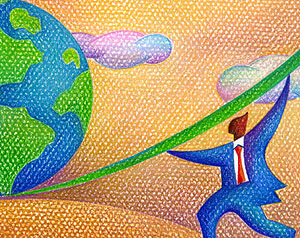A year ago, the implosion of the global economy prompted a huge flight to quality. Nobody wanted risky assets anymore. All they wanted was nice, safe, United States Treasury bonds.
The economy has stabilized since then, and that means that investors with access to lots of cheap money are once again becoming eager to invest in risky assets. Pimco’s Paul McCulley suggests that this makes perfect sense as long as everyone is convinced that the Fed will hold interest rates at zero for a long time, but then he admits that it’s all a bit of a paradox. After all, the Fed will only hold down interest rates if the economy continues to suck, in which case rising asset prices are just a big bubble. But if the economy recovers, thus justifying the high current prices of risky assets, then the Fed will raise interest rates and the whole thing will come crashing down. It’s a quandary.  In the end, though, he advises a bit half-heartedly that “the time has come to begin paring exposure to risk assets, and if their prices continue to rise, paring at an accelerated pace.”
In the end, though, he advises a bit half-heartedly that “the time has come to begin paring exposure to risk assets, and if their prices continue to rise, paring at an accelerated pace.”
And Nouriel Roubini? Well, Roubini doesn’t do anything half-heartedly. He says in no uncertain terms that we are completely and irrevocably fucked:
The US dollar has become the major funding currency of carry trades as the Fed has kept interest rates on hold and is expected to do so for a long time. Investors who are shorting the US dollar to buy on a highly leveraged basis higher-yielding assets and other global assets are not just borrowing at zero interest rates in dollar terms; they are borrowing at very negative interest rates — as low as negative 10 or 20 per cent annualised — as the fall in the US dollar leads to massive capital gains on short dollar positions.
….Yet, at the same time, the perceived riskiness of individual asset classes is declining as volatility is diminished due to the Fed’s policy of buying everything in sight….So the combined effect of the Fed policy of a zero Fed funds rate, quantitative easing and massive purchase of long-term debt instruments is seemingly making the world safe — for now — for the mother of all carry trades and mother of all highly leveraged global asset bubbles.
….But one day this bubble will burst, leading to the biggest co-ordinated asset bust ever….A stampede will occur as closing long leveraged risky asset positions across all asset classes funded by dollar shorts triggers a co-ordinated collapse of all those risky assets — equities, commodities, emerging market asset classes and credit instruments.
….This unraveling may not occur for a while, as easy money and excessive global liquidity can push asset prices higher for a while. But the longer and bigger the carry trades and the larger the asset bubble, the bigger will be the ensuing asset bubble crash. The Fed and other policymakers seem unaware of the monster bubble they are creating. The longer they remain blind, the harder the markets will fall.
Now that’s a cheery thought, isn’t it? Monstrous amounts of leverage are going to be employed bidding up assets of all kinds, and monstrous amounts of money are going to be made. As usual, everyone will assume they’ll be able to get out in time, and about 99% of those people will be wrong. Then: kaboom. The yen carry trade took down Iceland and a few hedge funds, but the dollar carry trade is going to take us down.
Well, maybe, maybe not. Roubini does seem to have some pretty sizable financial mood swings. But I have to admit that the stock market sure looks overvalued to me too. Corporate profits may be up for the moment, but belt tightening will only work for just so long. Eventually revenues need to rise, and it’s a little hard to see where that’s going to come from in the short term.
But I’m a pessimist. Even in good times I’m a pessimist. So who cares what I think?








